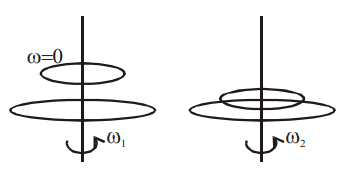Q. A circular disc of mass $M$ and radius $R$ is rotating about its axis with angular speed $\omega_{1}$. If another stationary disc having radius $\frac{ R }{2}$ and same mass $M$ is dropped co-axially on to the rotating disc. Gradually both discs attain constant angular speed $\omega_{2}$. The energy lost in the process is $p\%$ of the initial energy. Value of $p$ is ______.
Solution:
